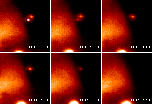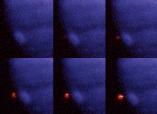Groundbased Studies of Io Volcanism
Summary
Starting in December 1989, we have been imaging thermal emission from
Io's volcanos
from earth-based
telescopes at the NASA Infrared Telescope
Facility in Hawaii, with an emphasis on good time resolution, high
spatial resolution, and short wavelengths (1.7 - 5 microns). Observations
have also been made at Lowell Observatory
starting in 1995. Eclipses
and occultations of Io by Jupiter are used to enhance sensitivity to
faint volcanos and to provide spatial resolution across the disk, even
in poor seeing.
Since 1995, we have obtained useful information on Io's volcanic
activity on over 250 nights. Two large outbursts have been seen, and several smaller
eruptions lasting a few weeks, at sites where activity had not been
seen before.
Spencer also coordinated the Io portion of the
IRTF Galileo Support Jupiter/Io Monitoring Program,
which obtained regular infrared images of Io's volcanic activity
between 1996 and 2001.
Whenever possible, we also obtained 1.6 - 5 micron images of Jupiter
to support the Galileo mission. These were analyzed by Glenn Orton
and his colleagues.
Images
Click on thumbnails for full resolution versions.

Two Io hot spots being occulted by Jupiter, 3.8 microns,
IRTF, 1990/10/12. (72 kbytes).
 Six Io volcanos
emerging in succession from behind Jupiter on August 26, 1995, at 3.5
microns. (266 K JPG). The color is artificial, and Jupiter, which is very
dark due to CH4 absorption, has been artificially brightened.
Six Io volcanos
emerging in succession from behind Jupiter on August 26, 1995, at 3.5
microns. (266 K JPG). The color is artificial, and Jupiter, which is very
dark due to CH4 absorption, has been artificially brightened.
Publications from the Ground-Based Program:
Spencer, J.R., M.A. Shure, M.E. Ressler, J.D. Goguen, W.M. Sinton, D. W.
Toomey, A. Denault, and J. Westfall (1990). Discovery of hotspots on Io using
disk-resolved infrared imaging. Nature 348 618-621.
Spencer, J. R., R. R. Howell, B. E. Clark, D. R. Klassen, and
D. O'Connor (1992). Volcanic activity on Io at the time of the
Ulysses encounter. Science, 257, 1507-1510.
Spencer, J. R., B. E. Clark, L. M. Woodney, W. M. Sinton, and
D. Toomey (1994). Io hot spots in 1991: Results from Europa occultation
photometry and infrared imaging. Icarus 107, 195-208.
Orton, G., and 37 co-authors including J. R. Spencer (1996).
Preliminary results of earth-based observations of the Galileo
probe entry site. Science 272,+ 839-840.
Spencer, J. R., J. A. Stansberry, C. Dumas, D. Vakil, R. Pregler,
M. Hicks, and K. Hege (1997). A History of High-Temperature Io
Volcanism: February 1995 to May 1997. Geophys. Res. Lett.
24, 2451-2454.
Stansberry, J. A., J. R. Spencer, R. R. Howell, C. Dumas, and
D. Vakil (1997). Violent Silicate Volcanism on Io in 1996.
Geophys. Res. Lett. 24, 2455-2458.
Blaney, D., G. Veeder, D. Matson, T. Johnson, J. Goguen,
and J. Spencer (1997). Io's thermal anomalies: Clues to their origin from
comparing ground based observations between 1 and 20 microns. Geophys.
Res. Lett. 24, 2459-2462.
Ortiz, J.L., G.S. Orton, A.J. Friedson, S.T. Stewart, B.M. Fisher,
and J.R. Spencer (1998). Evolution and persistence of 5-micron hot
spots at the Galileo probe entry latitude. J. Geophys. Res. 103, 23051-23069.
Howell, R.R., J.R. Spencer, J. D. Goguen, F. Marchis, R. Prange,
T. Fusco, D.L. Blaney, G.J. Veeder, J.A. Rathbun, G.S. Orton,
A.J. Grocholsky, J.A. Stansberry, G.S. Kanner, E.K. Hege (2001).
Ground-based observations of volcanism on Io in 1999 and
early 2000. J. Geophys. Res. 106, 33129-33139.
Loki, Io: A periodic volcano. J. A. Rathbun, J. R. Spencer,
A. G. Davies, R. R. Howell, and L. Wilson. Geophys. Res. Lett., in
press, 2002. PDF format.
Personnel:
John Spencer, U. Hawaii and Lowell Observatory, 1989-present
Bill Sinton, U. Hawaii, 1979-1991
Beth Clark, U. Hawaii, 1991 - 1994
Christophe Dumas, U. Hawaii, 1995 - 1997
John Stansberry, Lowell Observatory, 1995 - 1999
Julie Rathbun, Lowell Observatory and University of Redlands, 1999 -
Kandis Lea Jessup, Lowell Observatory, 2002 -
Return to Spencer home page

 Six Io volcanos
emerging in succession from behind Jupiter on August 26, 1995, at 3.5
microns. (266 K JPG). The color is artificial, and Jupiter, which is very
dark due to CH4 absorption, has been artificially brightened.
Six Io volcanos
emerging in succession from behind Jupiter on August 26, 1995, at 3.5
microns. (266 K JPG). The color is artificial, and Jupiter, which is very
dark due to CH4 absorption, has been artificially brightened.